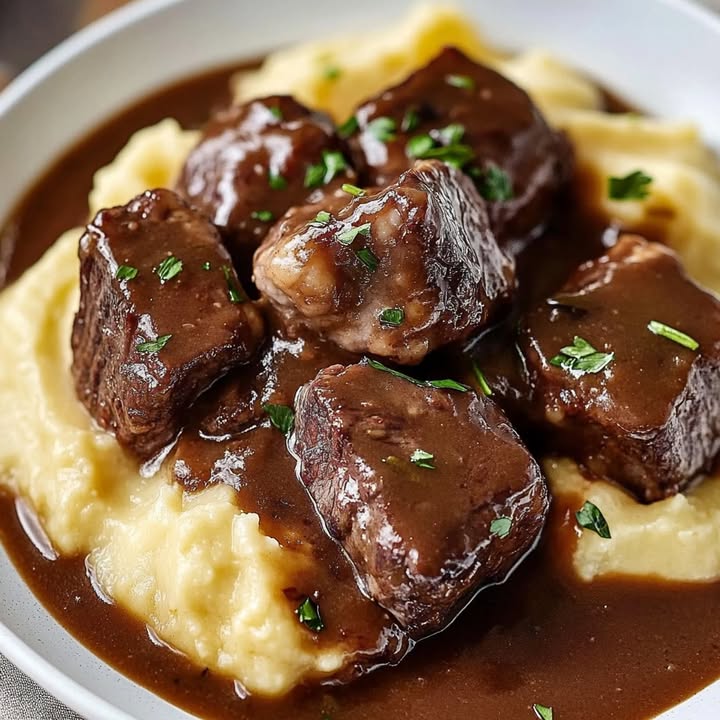
Why Braised Beef Purée Is a Game-Changing Comfort Dish
There’s something magical about the smell of slow-cooked beef filling your kitchen. I remember the first time I made this dish for my family—it was a chilly Sunday afternoon, and everyone was bundled up on the couch. When I served steaming bowls of braised beef with creamy homemade purée, the room lit up. It’s not just food; it’s a hug in a bowl. This recipe is special because it combines tender, melt-in-your-mouth beef with velvety mashed potatoes, creating a meal that feels like home no matter where you are.
The Story Behind Braised Beef Purée
Braised beef has deep roots in French cuisine, where slow-cooking transforms tough cuts of meat into tender masterpieces. Traditionally, dishes like boeuf bourguignon were peasant meals, designed to stretch humble ingredients into hearty dinners. Over time, chefs elevated these recipes, but their soul remains unchanged: simple, comforting, and deeply satisfying. My version adds a modern twist by pairing the rich, savory sauce with creamy homemade purée, making it perfect for today’s busy cooks who still crave authenticity.
Why You’ll Love This Recipe
This dish is all about flavor and ease. The beef becomes so tender it practically falls apart, while the sauce develops layers of umami goodness. Paired with buttery purée, every bite feels indulgent yet wholesome. Plus, it’s forgiving—if you’re new to cooking, don’t worry! This recipe is hard to mess up, even if you accidentally burn the onions (oops, been there). Whether you’re feeding picky kids or impressing dinner guests, this dish delivers.
Perfect Occasions for Braised Beef Purée
This dish shines during cozy gatherings—think family dinners, holiday feasts, or casual weekends at home. It’s also great for meal prep since leftovers taste even better the next day. Imagine coming home after a long day and reheating a bowl of this warm, comforting goodness. Trust me, your future self will thank you.
Ingredients for Braised Beef Purée
- 800 g of beef chuck or brisket, cut into chunks
- 2 tablespoons olive oil
- 1 large onion, thinly sliced
- 3 cloves garlic, minced
- 2 carrots, diced
- 2 celery stalks, chopped
- 400 ml beef broth
- 200 ml red wine (optional but recommended)
- 2 bay leaves
- Salt and pepper to taste
- 500 g potatoes, peeled and cubed
- 50 g butter
- 1/4 cup milk
Substitution Options
- Swap beef chuck for short ribs or oxtail for richer flavor.
- If you’re out of red wine, use extra beef broth mixed with a splash of vinegar.
- Replace regular potatoes with sweet potatoes for a sweeter purée.
- Use plant-based butter and milk for a vegan-friendly option.
Step 1: Browning the Beef
Heat olive oil in a large pot over medium-high heat. Pat the beef dry with paper towels—this helps it brown instead of steam. Add the beef pieces in batches, ensuring they aren’t crowded. Cook until each side turns golden-brown, releasing that irresistible aroma. Pro tip: Be patient! Rushing this step means losing out on the caramelized crust that adds depth to the dish.
Step 2: Sautéing the Aromatics
Once the beef is browned, remove it from the pot and set aside. In the same pot, sauté the onions until translucent, then toss in the garlic, carrots, and celery. Stir frequently to prevent burning, letting the vegetables soften and release their natural sweetness. This base builds the foundation of your sauce, so take your time here.
Step 3: Simmering the Beef
Return the beef to the pot and pour in the beef broth and red wine. Tuck in the bay leaves, season with salt and pepper, and bring everything to a gentle simmer. Lower the heat, cover the pot, and let it cook slowly for 2-3 hours. The low-and-slow method breaks down the tough fibers, resulting in fork-tender meat. Chef’s tip: Skim off any foam or excess fat during cooking for a cleaner sauce.
Step 4: Preparing the Purée
While the beef simmers, boil the potatoes until tender. Drain them well, then mash with butter and milk until smooth. For an extra silky texture, pass the potatoes through a ricer or sieve. Taste and adjust seasoning as needed. Pro tip: Warm the milk before adding it to keep the purée hot and fluffy.
Timing Breakdown
- Prep Time: 20 minutes
- Cooking Time: 3 hours
- Resting Time: 10 minutes (to let flavors meld)
- Total Time: Approximately 3 hours 30 minutes
Chef’s Secret
For an unexpected twist, stir a tablespoon of Dijon mustard into the sauce near the end of cooking. It adds a subtle tang that balances the richness of the beef perfectly.
Extra Info
Did you know? Slow-cooking tougher cuts of meat not only makes them tender but also enhances their flavor. That’s why dishes like braised beef have stood the test of time—they’re both practical and delicious.
Necessary Equipment
- Large heavy-bottomed pot or Dutch oven
- Wooden spoon or spatula
- Knife and cutting board
- Potato masher or ricer
- Measuring cups and spoons
Storage Tips
Braised beef stores beautifully in the fridge for up to 4 days. Transfer it to an airtight container once cooled. Reheat gently on the stovetop or microwave, adding a splash of broth to loosen the sauce. For longer storage, freeze portions in freezer-safe bags for up to 3 months. Thaw overnight in the fridge before reheating.
To store the purée, press plastic wrap directly onto its surface to prevent a skin from forming. Keep it refrigerated for up to 3 days or freeze for future use. Just reheat with a little milk to restore creaminess.
If freezing both components together, layer the purée under the beef to protect it from freezer burn. Label containers with dates to track freshness.
Tips and Advice
- Choose well-marbled beef for maximum flavor and tenderness.
- Don’t skip deglazing the pot after browning the beef—it lifts those flavorful bits stuck to the bottom.
- Adjust the thickness of the sauce by simmering uncovered toward the end.
- Taste as you go, adjusting seasoning gradually.
Presentation Ideas
- Serve individual portions in shallow bowls, placing a dollop of purée in the center and surrounding it with beef and sauce.
- Garnish with fresh parsley or thyme sprigs for a pop of color.
- Drizzle a swirl of olive oil over the top for a professional touch.
Healthier Alternatives
Looking to lighten things up? Try these variations:
- Leaner Meat: Use sirloin or turkey instead of beef for fewer calories.
- Low-Sodium Broth: Opt for reduced-sodium broth to control salt intake.
- Veggie Boost: Add mushrooms or spinach for extra nutrients.
- Cauliflower Purée: Swap half the potatoes with cauliflower for lower carbs.
- Herb-Infused Oil: Replace butter with infused oils like rosemary or garlic.
- Gluten-Free Sauce: Thicken the sauce with cornstarch instead of flour.
Mistake 1: Skipping the Browning Step
Browning the beef might seem optional, but trust me, it’s not. This step creates Maillard reactions, developing complex flavors that raw meat simply can’t offer. Without it, your dish risks tasting bland. To avoid this, ensure your pan is hot enough before adding the beef. Patience pays off!
Mistake 2: Overcooking the Vegetables
Sautéing the veggies too long can make them mushy and dull their vibrant flavors. Aim for softened but still slightly firm textures. Pro tip: Remove them from the heat just before they reach your desired doneness—they’ll continue cooking slightly from residual heat.
Mistake 3: Adding Cold Liquid to Hot Pot
Pouring cold broth into a hot pot can cause temperature fluctuations, affecting cooking consistency. Always warm liquids beforehand to maintain steady simmering. Your patience will result in evenly cooked, tender beef.
Mistake 4: Not Skimming the Fat
Failing to skim excess fat leaves your sauce greasy and unappetizing. Use a spoon to remove any accumulated fat from the surface while cooking. This small step makes a big difference in the final dish’s quality.
FAQ
What cut of beef works best?
Chuck or brisket are ideal because they become tender when slow-cooked. Avoid lean cuts like filet mignon, which lack the connective tissue needed for braising.
Can I make this ahead?
Absolutely! In fact, flavors deepen overnight. Prepare everything a day in advance, refrigerate, and reheat gently before serving.
Is red wine necessary?
No, but it adds depth. If skipping, enhance the broth with a splash of vinegar or tomato paste for acidity.
How do I fix a too-thick sauce?
Add more broth or water, a little at a time, stirring constantly until you reach the desired consistency.
Can I freeze leftovers?
Yes! Freeze in portioned containers for up to 3 months. Reheat gently with added broth if needed.
What sides pair well?
Crusty bread, green beans, or a simple salad complement this hearty dish nicely.
Why isn’t my beef tender?
It may need more time. Low-and-slow cooking is key. Check liquid levels to ensure the beef stays submerged.
Can I use a slow cooker?
Yes! Brown the beef and veggies first, then transfer everything to the slow cooker and cook on low for 6-8 hours.
What herbs work best?
Bay leaves, thyme, and rosemary pair beautifully with braised beef. Experiment to find your favorite combo.
How do I prevent lumpy purée?
Mash thoroughly and add warm milk gradually. Using a ricer ensures ultra-smooth results.
Final Thoughts
Braised Beef Purée is more than just a meal—it’s a celebration of comfort and connection. Whether you’re cooking for loved ones or treating yourself, this dish promises warmth and satisfaction. Give it a try, and watch how it brings people together around the table. Happy cooking!

Braised Beef Purée
Ingredients
Equipment
Method
- Heat olive oil in a large pot over medium-high heat and pat the beef dry.
- Add the beef pieces in batches and brown each side until golden-brown, then remove from the pot.
- Sauté onions in the same pot until translucent, then add garlic, carrots, and celery and soften them.
- Return the beef to the pot, pour in beef broth and red wine, add bay leaves, salt, and pepper, and bring to a simmer.
- Cover and cook slowly for 2-3 hours until the beef is fork-tender.
- Boil the potatoes until tender, then drain and mash with butter and milk until smooth.
